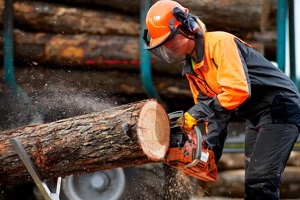
Logging and conducting business in forested areas can be complex, and with this complexity comes the potential for hazardous situations. Like other types of construction-centric industries, both logging and forestry come with a wide variety of insurance policies to choose from.
However, while the terms forestry and logging may often be used interchangeably, they are two distinct disciplines, and the types of insurance coverage that is suitable for them generally differ with a small area of overlap. Here’s what you need to know to tell the difference between forestry insurance and logging insurance.
Elements Unique to Forestry Insurance
In order to understand the types of forestry insurance that a company may need, it is first important to realize what forestry means and what types of activities usually pose the most risk. Forestry insurance covers general logging operations, but it goes beyond that to cover timberland and many of the processes that go into converting timber to a usable form. Entities ranging from individual farmers to pulp and paper mills can be covered by forestry insurance.
In addition to individual coverage, forestry insurance often includes coverage for the expensive equipment used in the process, such as trucks and trailers, as well as all of the related insurance for their operation (like interstate trucking insurance). Unlike other types of construction coverage, forestry insurance focuses more heavily on the potential for natural disasters and usually includes some protection against acts of God and weather like hail, lightning, flooding, and fires.
It is important to be aware that forestry insurance is not the same thing as forest insurance, although depending upon your company’s needs, you may end up purchasing both. While forestry insurance covers many of the transactional costs of arboriculture, such as equipment damage, forest insurance protects the land itself. It is a type of property coverage that shields owners against loss of trees and other vegetation due to a variety of potential causes, ranging from natural disasters and floods to animal interference, vandalism, and more.
What Makes Logging Insurance Unique
Logging insurance is typically more specific than forestry insurance, and it focuses on the day-to-day occurrences during a logging project that may present risk. For example, unloading and loading liability insurance is more common here than in other types of construction or trucking industries because large trees can cause significant damage or even a total loss if loading should go wrong.
Similarly, these large trees can bring down power lines if they do not fall as intended, which is why many logging companies opt for power line damage insurance. Another popular type of coverage, accidental overcut protection, shields a logging company from liability if it makes a mistake in the area in which it is supposed to be logging.
An employee may, for instance, read a map incorrectly and end up logging in a tract that was allocated to someone else or meant to remain untouched. These problems are unique to loggers, which is why they are not always found in general forestry coverage.
Where the Overlap Lies

While logging and forestry each span their own individual fields, there is some overlap in the types of coverage that they both offer depending on your needs. Both forestry and logging insurance usually include pollution coverage because most methods of handling and processing forest material can result in pollution to the natural environment if adequate care is not taken.
Like most companies that work with large or heavy equipment, both forestry and logging insurance policies will also usually include general liability insurance and even workers’ compensation insurance. Additionally, while it is not often innately included in the policy, both logging and forestry coverage may have the option to add riders for niche practices or equipment, such as helicopters and aircraft. The inclusion of these elements will depend upon the type of forestry or logging that the company is doing.
Trust the Pros to Help You Craft the Right Mixture of Insurance Coverage
Depending upon the type of business you operate and how it engages with the natural world, you may need forestry coverage, logging coverage, or even a mixture of both. Determining the right blend for your needs can feel like a challenge, especially when trying to ensure that you are adequately protected without spending unnecessary money on coverage you probably don’t need.
The experts at Burton & Company can help you understand your areas of greatest risk so that you can make the right insurance decisions for your business. Reach out to learn more about our services or to schedule an appointment to get started.
Burton & Company’s team of experienced insurance advisors will analyze your risks and offer you a tailored insurance plan that aligns with your requirements and budget. Contact us today to discover how we can secure your valuable assets and provide you with peace of mind, so you can focus on what truly matters.

